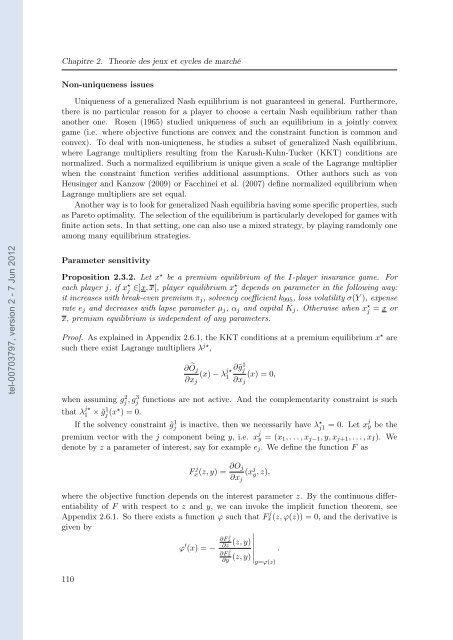Etude des marchés d'assurance non-vie à l'aide d'équilibres de ...
Etude des marchés d'assurance non-vie à l'aide d'équilibres de ...
Etude des marchés d'assurance non-vie à l'aide d'équilibres de ...
Create successful ePaper yourself
Turn your PDF publications into a flip-book with our unique Google optimized e-Paper software.
tel-00703797, version 2 - 7 Jun 2012<br />
Chapitre 2. Theorie <strong><strong>de</strong>s</strong> jeux et cycles <strong>de</strong> marché<br />
Non-uniqueness issues<br />
Uniqueness of a generalized Nash equilibrium is not guaranteed in general. Furthermore,<br />
there is no particular reason for a player to choose a certain Nash equilibrium rather than<br />
another one. Rosen (1965) studied uniqueness of such an equilibrium in a jointly convex<br />
game (i.e. where objective functions are convex and the constraint function is common and<br />
convex). To <strong>de</strong>al with <strong>non</strong>-uniqueness, he studies a subset of generalized Nash equilibrium,<br />
where Lagrange multipliers resulting from the Karush-Kuhn-Tucker (KKT) conditions are<br />
normalized. Such a normalized equilibrium is unique given a scale of the Lagrange multiplier<br />
when the constraint function verifies additional assumptions. Other authors such as von<br />
Heusinger and Kanzow (2009) or Facchinei et al. (2007) <strong>de</strong>fine normalized equilibrium when<br />
Lagrange multipliers are set equal.<br />
Another way is to look for generalized Nash equilibria having some specific properties, such<br />
as Pareto optimality. The selection of the equilibrium is particularly <strong>de</strong>veloped for games with<br />
finite action sets. In that setting, one can also use a mixed strategy, by playing ramdomly one<br />
among many equilibrium strategies.<br />
Parameter sensitivity<br />
Proposition 2.3.2. Let x⋆ be a premium equilibrium of the I-player insurance game. For<br />
each player j, if x⋆ j ∈]x, x[, player equilibrium x⋆j <strong>de</strong>pends on parameter in the following way:<br />
it increases with break-even premium πj, solvency coefficient k995, loss volatility σ(Y ), expense<br />
rate ej and <strong>de</strong>creases with lapse parameter µj, αj and capital Kj. Otherwise when x⋆ j = x or<br />
x, premium equilibrium is in<strong>de</strong>pen<strong>de</strong>nt of any parameters.<br />
Proof. As explained in Appendix 2.6.1, the KKT conditions at a premium equilibrium x ⋆ are<br />
such there exist Lagrange multipliers λ j⋆ ,<br />
∂ Oj<br />
∂xj<br />
(x) − λ j⋆ ∂˜g<br />
1<br />
1 j<br />
(x) = 0,<br />
∂xj<br />
when assuming g2 j , g3 j functions are not active. And the complementarity constraint is such<br />
that λ j⋆<br />
1 × ˜g1 j (x⋆ ) = 0.<br />
If the solvency constraint ˜g 1 j is inactive, then we necessarily have λ⋆ j1 = 0. Let xjy be the<br />
premium vector with the j component being y, i.e. x j y = (x1, . . . , xj−1, y, xj+1, . . . , xI). We<br />
<strong>de</strong>note by z a parameter of interest, say for example ej. We <strong>de</strong>fine the function F as<br />
F j x(z, y) = ∂Oj<br />
(x<br />
∂xj<br />
j y, z),<br />
where the objective function <strong>de</strong>pends on the interest parameter z. By the continuous differentiability<br />
of F with respect to z and y, we can invoke the implicit function theorem, see<br />
Appendix 2.6.1. So there exists a function ϕ such that F j x(z, ϕ(z)) = 0, and the <strong>de</strong>rivative is<br />
given by<br />
∂F j <br />
<br />
x (z, y) <br />
110<br />
ϕ ′ (x) = −<br />
∂z<br />
∂F j x<br />
∂y<br />
<br />
<br />
(z, y)<br />
y=ϕ(z)<br />
.
















